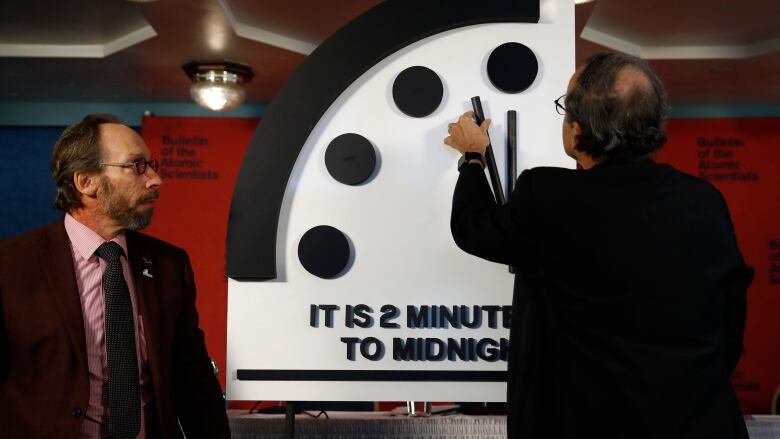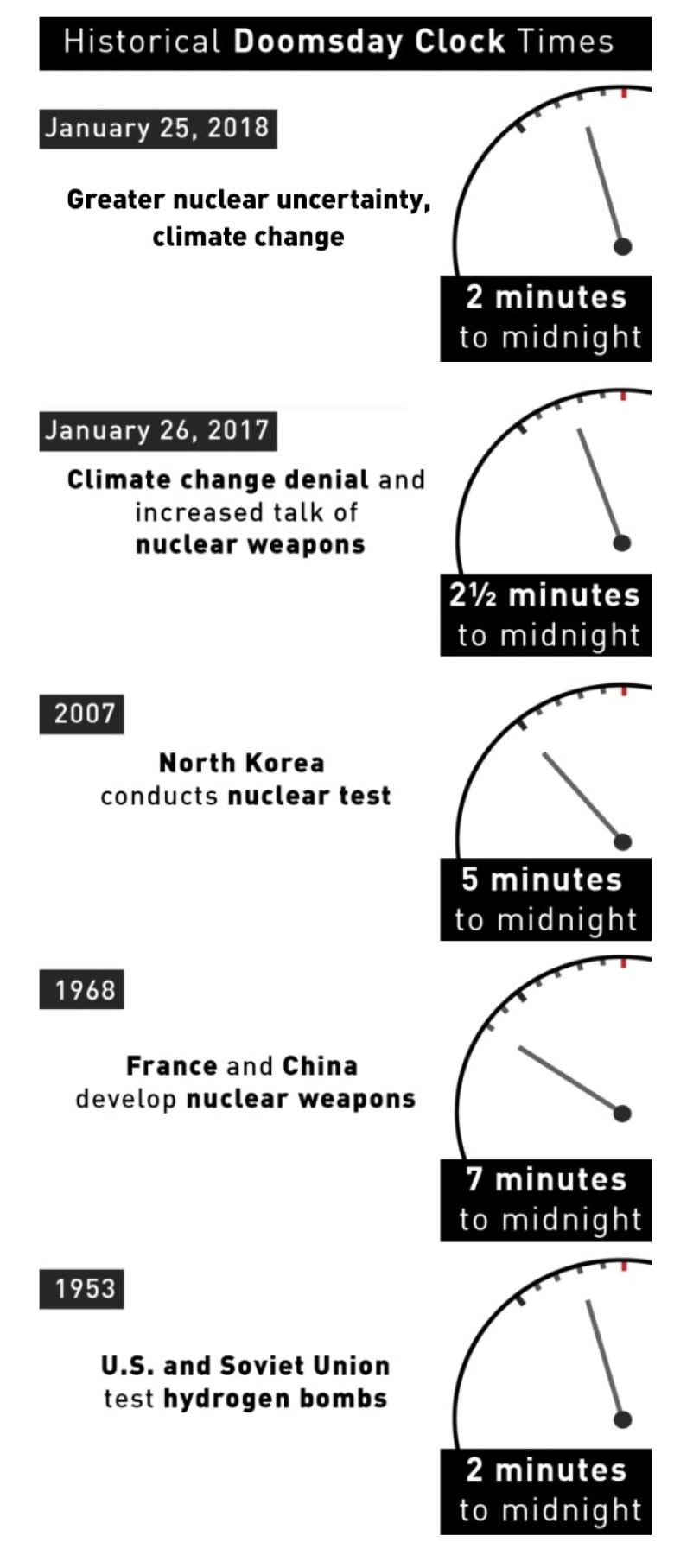Scientists move Doomsday Clock ahead to 2 minutes to midnight
2nd time the clock, used as a metaphor to measure how close we are to destruction, has moved 30 seconds

The Bulletin of Atomic Scientists has moved the Doomsday Clock ahead by 30 seconds to 11:58 p.m. the symbolic timeof civilization's destruction.
"It is with considerableconcernthat we set the Doomsday Clock, as of today," Rachel Bronson, president and CEO of the organization,said during a newsconference at the National Press Club in Washington, D.C. "It is two minutes to midnight."
The clock, first used in 1947, is a metaphor meant to measurehow close we are to destroying the world. This is the second time the clock has come this close to midnight. The first was in 1953, after both the U.S. and Soviet Union tested their first thermonuclear bombs within six months of one another.
To call the world's nuclear state direis to understate the danger and its immediacy.- Rachel Bronson, Bulletin of Atomic Scientists
The first time the Doomsday Clockmoved was after the Soviet Union successfully tested its first atomic bomb in 1949. It moved from the original seven minutes to midnight, to three minutes to midnight.
LawrenceKrauss, chair of the Bulletin, said, "The danger of some sort of nuclear catastropheis greater than it was in the Cold War."
In 1991, at the end of the Cold War, the hands moved the farthest they've ever been: 17 minutes to midnight.
In an uncharacteristic move, the scientists moved the clock by 30 seconds in 2017, to 2 minutes to midnight. Typically, the clock is moved by the minute.
The bulletin said at the time: "The probability of global catastrophe is very high, and the actions needed to reduce the risks of disaster must be taken very soon."
There have been heightened tensions between the U.S. and North Korea over the past few months, which Bronson said did influence the changing of the time.
"To call the world's nuclear state direis to understate the danger and its immediacy," said Bronson.
Just two days into the new year, U.S. President Donald Trump responded to a remark by North Korean leader Kim Jong-unthathe had a nuclear button on his desk by tweeting:"North Korean Leader Kim Jong Un just stated that the 'Nuclear Button is on his desk at all times. Will someone from his depleted and food starved regime please inform him that I too have a Nuclear Button, but it is a much bigger & more powerful one than his, and my Button works!"
North Korean Leader Kim Jong Un just stated that the Nuclear Button is on his desk at all times. Will someone from his depleted and food starved regime please inform him that I too have a Nuclear Button, but it is a much bigger & more powerful one than his, and my Button works!
—@realDonaldTrumpWhile there has been some easing of tensions between North and South Korea after they agreed to participate in the Winter Olympics as one team, there are concerns about North Korea's nuclear missiles.
The country has reportedly conducted several tests of its rockets, with the latest capable of delivering a nuclear warhead to North America just last November.

More than a nuclear risk
The group of scientists cited concerns of climate change and technological innovation,including artificial intelligence and cyber threats, in moving up the time.
Sivan Kartha, who heads the bulletin's science and security board and is a senior scientist at the Stockholm Environmental Institute, emphasized concerns overclimate change, noting that in 1953, the only time the clock has been this close to midnight, it wasn't even an issue.
"Since that time whatwe've dumped into the atmosphere has increased sixfold. And as a consequence, Earth has warmed by one degree,"Karthasaid.
He noted decreasing ice in the Arctic, as well as catastrophic events such as the wildfires across the U.S. and Canada.
The group also cited concerns over public distrust of political leaders and the media, saying it is drawing away from the focus on real threats.
"The nuclear situation this year is a strong concern," said Krauss."We feel the world is getting more dangerous."












_(720p).jpg)


 OFFICIAL HD MUSIC VIDEO.jpg)
.jpg)



























































































